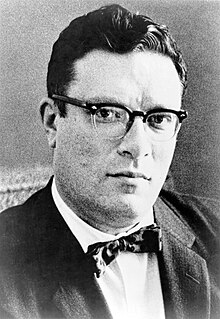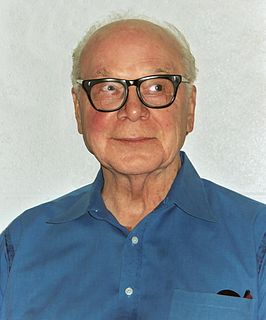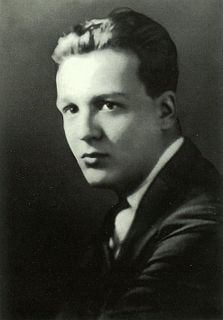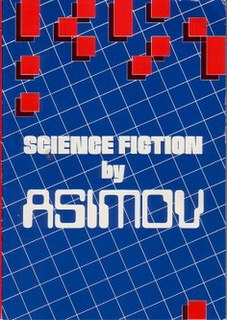External links
- "Eyes Do More Than See" title listing at the Internet Speculative Fiction Database
- "Eyes Do More Than See" on the Internet Archive
| "Eyes Do More Than See" | |
|---|---|
| Author | Isaac Asimov |
| Country | United States |
| Language | English |
| Genre(s) | Science fiction |
| Published in | The Magazine of Fantasy and Science Fiction |
| Publication type | Periodical |
| Publisher | Fantasy House |
| Media type | Print (Magazine, Hardback & Paperback) |
| Publication date | April 1965 |
"Eyes Do More Than See" is a science fiction short story by American writer Isaac Asimov.
In 1964, Playboy magazine approached several science fiction writers to create short-short stories based on a photograph of a clay head without ears. The selected stories — Arthur C. Clarke's "Playback", Frederik Pohl's "Lovemaking", and Thomas M. Disch's "Cephalatron" (later "Fun with Your New Head") — were published in the December 1966 issue. [1]
Playboy had rejected Asimov's story, so he submitted it to the Magazine of Fantasy and Science Fiction , which published it in April 1965. The story has since been anthologized several times and was included in Asimov's collection Nightfall and Other Stories (1969).
The story was nominated for the 1966 Nebula Award for Best Short Story.
In the very distant future — about a trillion years in the future — humans have long since abandoned physical form. They exist as energy entities spanning space.
Two of these entities, known only as Ames and Brock, tire of artistic competitions using manipulations of energy. They discuss a new project in which they attempt to manipulate physical matter, and Ames creates a sculpture of a human head. Brock, who was once a woman, is painfully reminded of her physical past and that she once knew love. She adds tears to the head and then flees. Ames remembers that he had once been a man, and the force of his vortex splits the head as he turns in search of Brock.

Isaac Asimov was an American writer and professor of biochemistry at Boston University. He was known for his works of science fiction and popular science. Asimov was a prolific writer, and wrote or edited more than 500 books. He also wrote an estimated 90,000 letters and postcards.

Philip José Farmer was an American author known for his science fiction and fantasy novels and short stories.

Stanley Grauman Weinbaum was an American science fiction writer. His first story, "A Martian Odyssey", was published to great acclaim in July 1934; the alien Tweel was arguably the first character to satisfy John W. Campbell's challenge: "Write me a creature who thinks as well as a man, or better than a man, but not like a man." Weinbaum wrote more short stories and a few novels, but died from lung cancer less than a year and a half later.

John Stewart Williamson, who wrote as Jack Williamson, was an American science fiction writer, often called the "Dean of Science Fiction". He is also credited with one of the first uses of the term "genetic engineering". Early in his career he sometimes used the pseudonyms Will Stewart and Nils O. Sonderlund.
"Blind Alley" is a science fiction short story by American writer Isaac Asimov. It was first published in the March 1945 issue of Astounding Science Fiction, and later included in the collection The Early Asimov (1972).
"Reason" is a science fiction short story by American writer Isaac Asimov, first published in the April 1941 issue of Astounding Science Fiction and collected in I, Robot (1950), The Complete Robot (1982), and Robot Visions (1990). It is part of Asimov's Robot series, and was the second of Asimov's positronic robot stories to see publication.

"The Ugly Little Boy" is a science fiction short story by American writer Isaac Asimov. The story first appeared in the September 1958 issue of Galaxy Science Fiction under the title "Lastborn", and was reprinted under its current title in the 1959 collection Nine Tomorrows. The story deals with a Homo neanderthalensis child which is brought to the future by means of time travel. Robert Silverberg later expanded it into a novel with the same title published in 1992.
Michael Lawson Bishop is an American writer. Over four decades and in more than thirty books, he has created what has been called a "body of work that stands among the most admired and influential in modern science fiction and fantasy literature."

Nightfall and Other Stories (1969) is a collection of 20 previously published science fiction short stories by Isaac Asimov. Asimov added a brief introduction to each story, explaining some aspect of the story's history and/or how it came to be written.
"The Dead Past" is a science fiction short story by American writer Isaac Asimov, first published in the April 1956 issue of Astounding Science Fiction. It was later collected in Earth Is Room Enough (1957) and The Best of Isaac Asimov (1973), and adapted into an episode of the science-fiction television series Out of the Unknown. Its pattern is that of dystopian fiction, but of a subtly nuanced flavor. It is considered by some people to be one of his best short stories.
Hyperspace is a concept from science fiction and cutting-edge science relating to higher dimensions and a superluminal method of interstellar travel. It is typically described as an alternative "sub-region" of space co-existing with our own universe. In much of science fiction, hyperspace is described as a physical place that can be entered and exited using a rubber science energy field or similar phenomena generated by a shipboard device often known as a "hyperdrive". The superluminal function of the concept is therefore facilitated by the fact that, once in hyperspace, the laws of general and special relativity do not necessarily behave in the same way when compared to normal spacetime, allowing travelers through hyperspace to go astronomical distances in periods of time far shorter than what an analogous object traveling at the speed of light would take traveling said distance in normal spacetime. This allows for apparent faster-than-light travel, which is necessary to have practical, human-timescale travel across outer space.

The Best Science Fiction of Isaac Asimov, published in 1986, is a collection of 28 short stories by American writer Isaac Asimov, personally selected as favorites by himself.
"Not Final!" is a science fiction short story by American writer Isaac Asimov, originally published in the October 1941 issue of Astounding Science Fiction, and included in the 1972 collection The Early Asimov. Its sequel, "Victory Unintentional", is a robot story. These are two of the few stories by Asimov to postulate non-human intelligences in the Solar system.

Sucker Bait is a science fiction novella by American writer Isaac Asimov. It was first serialized in the February and March 1954 issues of Astounding Science Fiction, and reprinted in the 1955 collection The Martian Way and Other Stories. It has also been adapted as an episode of the BBC anthology television series Out of the Unknown.

"Founding Father" is a science fiction short story by American writer Isaac Asimov. It was first published in the October 1965 issue of Galaxy Science Fiction, and reprinted in the 1975 collection Buy Jupiter and Other Stories. It was inspired by a cover painting of a space-helmeted face backed by several crosses, provided by the magazine's editor, Frederik Pohl.

"What Is This Thing Called Love?" is a science fiction short story by American writer Isaac Asimov. The story was requested by Cele Goldsmith Lalli, editor of Amazing Stories, as a satire of an article in Playboy called "Girls of the Slime God" which had suggested that pulp science fiction stories were concerned with aliens and sex. The story appeared in the March 1961 issue of Amazing as "Playboy and the Slime God", but Asimov later retitled it "What Is This Thing Called Love?"

Science Fiction by Asimov is a collection of stories by American author Isaac Asimov. Published by Davis Publications in 1986, it was given away free to subscribers of Asimov's SF Magazine.

Marvel Science Stories was an American pulp magazine that ran for a total of fifteen issues in two separate runs, both edited by Robert O. Erisman. The publisher for the first run was Postal Publications, and the second run was published by Western Publishing; both companies were owned by Abraham and Martin Goodman. The first issue was dated August 1938, and carried stories with more sexual content than was usual for the genre, including several stories by Henry Kuttner, under his own name and also under pseudonyms. Reaction was generally negative, with one reader referring to Kuttner's story "The Time Trap" as "trash". This was the first of several titles featuring the word "Marvel", and Marvel Comics came from the same stable in the following year.

The Asimov Chronicles: Fifty Years of Isaac Asimov is a collection of short science fiction stories, mystery stories and science essays by American writer Isaac Asimov, published by Dark Harvest in May 1989.
AI takeover is a common theme in science fiction. Famous cultural touchstones include Terminator and The Matrix.